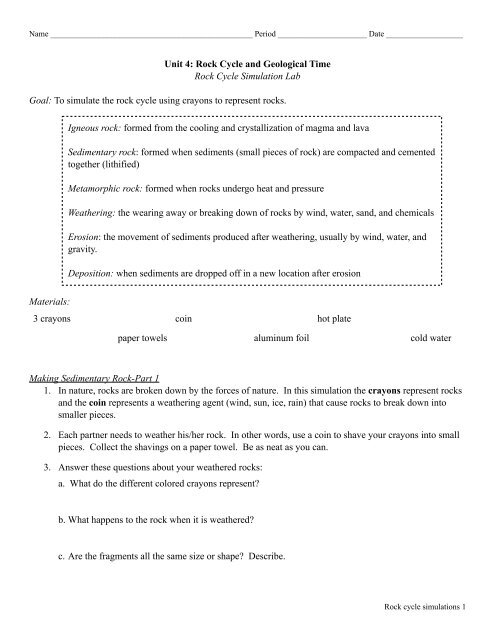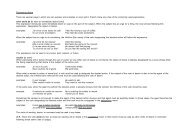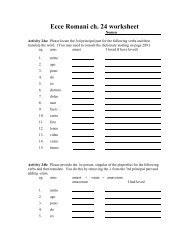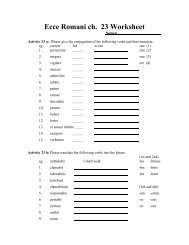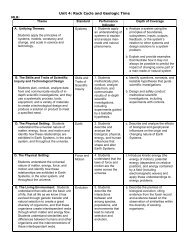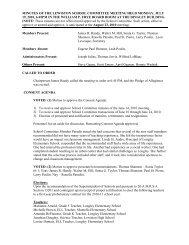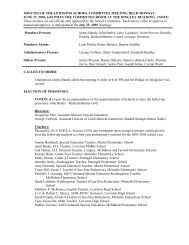Rock Cycle Crayon lab.pdf - Lewiston School District
Rock Cycle Crayon lab.pdf - Lewiston School District
Rock Cycle Crayon lab.pdf - Lewiston School District
Create successful ePaper yourself
Turn your PDF publications into a flip-book with our unique Google optimized e-Paper software.
Name __________________________________________________ Period ______________________ Date ___________________<br />
Unit 4: <strong>Rock</strong> <strong>Cycle</strong> and Geological Time<br />
<strong>Rock</strong> <strong>Cycle</strong> Simulation Lab<br />
Goal: To simulate the rock cycle using crayons to represent rocks.<br />
Materials:<br />
Igneous rock: formed from the cooling and crystallization of magma and lava<br />
Sedimentary rock: formed when sediments (small pieces of rock) are compacted and cemented<br />
together (lithified)<br />
Metamorphic rock: formed when rocks undergo heat and pressure<br />
Weathering: the wearing away or breaking down of rocks by wind, water, sand, and chemicals<br />
Erosion: the movement of sediments produced after weathering, usually by wind, water, and<br />
gravity.<br />
Deposition: when sediments are dropped off in a new location after erosion<br />
3 crayons coin hot plate<br />
paper towels aluminum foil cold water<br />
Making Sedimentary <strong>Rock</strong>-Part 1<br />
1. In nature, rocks are broken down by the forces of nature. In this simulation the crayons represent rocks<br />
and the coin represents a weathering agent (wind, sun, ice, rain) that cause rocks to break down into<br />
smaller pieces.<br />
2. Each partner needs to weather his/her rock. In other words, use a coin to shave your crayons into small<br />
pieces. Collect the shavings on a paper towel. Be as neat as you can.<br />
3. Answer these questions about your weathered rocks:<br />
a. What do the different colored crayons represent?<br />
b. What happens to the rock when it is weathered?<br />
c. Are the fragments all the same size or shape? Describe.<br />
<strong>Rock</strong> cycle simulations 1
Name __________________________________________________ Period ______________________ Date ___________________<br />
d. Would you expect all rock fragments in nature to be the same size and shape?<br />
e. Identify 3 weathering agents (natural ways to weather a rock).<br />
4. Once rock fragments have been created, they are usually moved (eroded) by some force of nature like<br />
gravity and dropped in a new location (deposition). Here you will act as a depositional force.<br />
5. Each <strong>lab</strong> partner, in turn, should move (erode) and lay down (deposit) the rock fragments in a neat pile<br />
in the center of the foil. Set each new pile on top of the previous ones.<br />
6. Answer the following questions:<br />
a. Describe the shape and size of spaces between your rock (crayon) pieces. Are they large or small<br />
and irregular or regular shaped?<br />
b. What happens to the sediments during erosion?<br />
c. Identify 3 erosion agents.<br />
d. What happens to the sediments during deposition?<br />
7. This part of the simulation requires you to understand the cementation process. Spaces between the<br />
fragments are reduced in size by pressure (compaction) and filled in with cementing agents<br />
(cementation). This simulation will not add cementing agents. It will only simulate compaction. The<br />
compaction process occurs as sediment layers are continually covered by new layers of sediments. The<br />
lower layers become compacted by the weight of the new layers above.<br />
8. Carefully fold the loose layers of crayon shavings inside the aluminum foil creating a packet.<br />
9. Press the packet between the palms of your hands and press firmly. You can also place the packet on the<br />
table, put your palms of your hands on the top of the packet, and press down. This will compact your<br />
weather and eroded rocks (crayon shavings).<br />
10. Answer the following questions:<br />
a. Describe the compaction. Are the sediments tightly or loosely compacted?<br />
<strong>Rock</strong> cycle simulations 2
Name __________________________________________________ Period ______________________ Date ___________________<br />
b. Do you see any layers? Are they thin or thick?<br />
c. Which type of rock is formed after all of these processes (weathering, erosion, deposition,<br />
compaction and cementation) have occurred?<br />
11. Save one small piece of the “sedimentary rock.”<br />
Making a Metamorphic <strong>Rock</strong>-Part 2<br />
12. As the rocks are pushed deeper into the Earth’s crust, pressure and temperature increases. Metamorphic<br />
rock may become contorted in appearance and actually flow like a plastic material in response to the<br />
heat and pressure that is caused by the overlying rocks.<br />
13. Rewrap the loosely compacted, sedimentary rock-type crayons shavings in the aluminum foil.<br />
14. Bring your folded packet to the front of the classroom to apply heat and pressure to your sedimentary<br />
rock.<br />
15. Answer the following questions:<br />
a. Do you see any layers? Describe any layers that you see.<br />
b. What type of rock is formed by heat and pressure?<br />
c. In nature, what is causing the increase in temperature and pressure?<br />
16. Save one small piece of the “metamorphic rock.”<br />
Making Igneous <strong>Rock</strong>- Part III<br />
17. Igneous rocks form deep within the earth. They originate in magma chambers embedded in solid rock.<br />
18. Take your remaining crayon rock in the aluminum foil to the front of the classroom to be melted. The<br />
cooling process will then form igneous rock.<br />
19. Answer the following questions:<br />
a. Describe what the melted “rock” (magma) looked like.<br />
<strong>Rock</strong> cycle simulations 3
Name __________________________________________________ Period ______________________ Date ___________________<br />
b. Describe the cooling process and the final appearance of the “igneous” rock.<br />
c. Would your igneous rock be considered an intrusive or extrusive rock? Explain.<br />
16. Save one small piece of the “igneous rock.”<br />
Conclusions-Part IV<br />
Look at all three “rock” samples. Use your simulated “rocks” to help you describe the following rock types.<br />
1. What is a sedimentary rock?<br />
2. What processes must occur to produce a sedimentary rock?<br />
3. What is a metamorphic rock?<br />
4. What processes must occur to produce a metamorphic rock?<br />
5. What is an igneous rock?<br />
6. What processes must occur to produce an igneous rock?<br />
7. What is the difference between an extrusive and intrusive igneous rock?<br />
8. Is there evidence of the original rocks (the 3 crayons) in the igneous, metamorphic, and sedimentary<br />
rocks that you made? Explain.<br />
<strong>Rock</strong> cycle simulations 4


